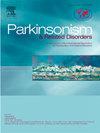Local field potentials and motor performances modulation in response to stimulation and levodopa: a study on Parkinson's disease patients on chronic deep brain stimulation
IF 3.1
3区 医学
Q2 CLINICAL NEUROLOGY
引用次数: 0
Abstract
Introduction
Subthalamic (STN) local field potentials (LFP) in the beta band are considered potential biomarkers for closed-loop deep brain stimulation (DBS) in Parkinson's disease (PD). Studies focusing on chronic STN LFP modulation in response to stimulation and treatment are scant. Deepening knowledge on beta modulation during chronic stimulation could aid the development of solid computational algorithm for adaptive DBS.
This study aimed to investigate: 1) the presence of beta peaks in the first 21 patients receiving the Percept PC at our Tertiary Centre; 2) the influence of medications, stimulation, and plasma levodopa levels on beta-peaks magnitude and motor performances.
Methods
Twenty-one (19 males, 2 females) consecutive PD patients who underwent bilateral STN-DBS surgery were prospectively recruited. At 6 months after surgery, an extensive and systematic evaluation of raw LFP, motor performances, and plasma levodopa levels was conducted in the following four conditions: OFF-medications/ON-stimulation; OFF-medications/OFF-stimulation; ON-medications/OFF-stimulation; ON-medications/ON-stimulation.
Results
Analysis of STN LFP revealed that 76.2 % (16/21) of PD patients showed a beta peak. Beta peaks was identified at an average frequency of 21.0 ± 5.4 Hz, with an amplitude of 1.1 ± 0.8 μV/rtHz. A higher significant reduction of beta STN oscillations was observed following stimulation activation (p < 0.001) compared to levodopa administration. LFP amplitude patterns reflected motor performance trends across the four treatment conditions.
Conclusion
This study provides a comprehensive and systematic evaluation of LFP behaviour in response to stimulation and medication, conducted during ongoing stimulation and in the chronic state. These findings enhance understanding of beta oscillatory changes related to therapies and stimulation.
刺激和左旋多巴对局部场电位和运动表现的调节:帕金森病患者慢性深部脑刺激的研究
β带下丘脑(STN)局部场电位(LFP)被认为是帕金森病(PD)闭环深部脑刺激(DBS)的潜在生物标志物。关注慢性STN LFP调节对刺激和治疗的反应的研究很少。加深对慢性刺激期间β调制的了解有助于自适应DBS的可靠计算算法的发展。本研究旨在探讨:1)在我们的三级中心接受percepept PC治疗的前21例患者中存在β峰;2)药物、刺激和血浆左旋多巴水平对β峰幅度和运动表现的影响。方法前瞻性招募21例连续行双侧STN-DBS手术的PD患者(男19例,女2例)。术后6个月,在以下四种情况下,对原始LFP、运动表现和血浆左旋多巴水平进行了广泛而系统的评估:off -medication /ON-stimulation;摆脱药物/ OFF-stimulation;药物/ OFF-stimulation;药物/刺激。结果STN LFP分析显示,76.2%(16/21)的PD患者出现β峰。β峰的平均频率为21.0±5.4 Hz,幅值为1.1±0.8 μV/rtHz。刺激激活后观察到β - STN振荡的显著减少(p <;0.001),与左旋多巴相比。LFP振幅模式反映了四种治疗条件下的运动表现趋势。结论本研究对LFP在持续刺激和慢性状态下对刺激和药物反应的行为进行了全面和系统的评估。这些发现加强了对治疗和刺激相关的β振荡变化的理解。
本文章由计算机程序翻译,如有差异,请以英文原文为准。
求助全文
约1分钟内获得全文
求助全文
来源期刊

Parkinsonism & related disorders
医学-临床神经学
CiteScore
6.20
自引率
4.90%
发文量
292
审稿时长
39 days
期刊介绍:
Parkinsonism & Related Disorders publishes the results of basic and clinical research contributing to the understanding, diagnosis and treatment of all neurodegenerative syndromes in which Parkinsonism, Essential Tremor or related movement disorders may be a feature. Regular features will include: Review Articles, Point of View articles, Full-length Articles, Short Communications, Case Reports and Letter to the Editor.
 求助内容:
求助内容: 应助结果提醒方式:
应助结果提醒方式:


